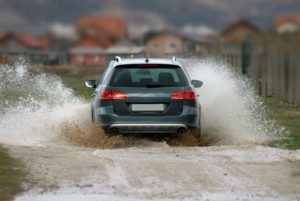Driving can be an enjoyable experience, but in a flash, it can turn scary. One of the most horrifying events is when your car hydroplanes. Despite what some people might think, you can actually do something about the situation, instead of just waiting for it to play out and dealing with the consequences. To learn how to control a hydroplaning car, you must understand what causes it. With that knowledge, correcting the problem is simple.
Causes of Hydroplaning
 When being honest, most people will ask: what is hydroplaning? Simply put, hydroplaning is when water that has accumulated on the road is high enough that it sits between your tires and the actual road surface. In other words, the rubber is no longer touching pavement, and the car is essentially skipping along.
When being honest, most people will ask: what is hydroplaning? Simply put, hydroplaning is when water that has accumulated on the road is high enough that it sits between your tires and the actual road surface. In other words, the rubber is no longer touching pavement, and the car is essentially skipping along.
This situation is dangerous because hydroplaning means your tires have zero traction. Without traction, you can’t really steer, brake, accelerate, or have much control of your car.
Three factors determine the risk of hydroplaning:
- Your speed
- The depth of your tire tread
- The depth of the standing water on the road
Your tires are designed with channels in the tread that push water out to the edges. This is so the tread contacts relatively dry pavement while the water is constantly funneled away. How much water can cause hydroplaning really depends on the tire. Too much water will overwhelm any tire, no matter how deep the tread. The quicker the car is moving, the less time the tread has to push the water out of the way.
How to Prevent Hydroplaning
Can hydroplaning be prevented? To an extent, yes, but even the most careful driver can experience this situation.
One of the biggest factors that affects hydroplaning is your tires. You should keep them properly inflated at all times. Tires that have too little air pressure don’t have their entire tread touching the road surface. That means whatever liquid channels that are built into the tread might not function as designed, or maybe at all.
The same idea goes for tires that are worn down. Tread patterns that are shallow can’t channel nearly as much water as fresh tires, so you’re more likely to hydroplane.
 If it’s raining, or for some other reason you see water on the road, slow down. Don’t slam on the brakes, but do cut your speed significantly. Keep steering wheel movements gradual and not sudden.
If it’s raining, or for some other reason you see water on the road, slow down. Don’t slam on the brakes, but do cut your speed significantly. Keep steering wheel movements gradual and not sudden.
Some people say never to use cruise control during a rainstorm. While cruise control might not cause you to hydroplane, it’s still a risk factor. If you have the setting too high for the conditions, you might accelerate when you should be slowing down, because the cruise control system doesn’t adjust to environmental factors. Also, if a situation occurs that requires you to quickly hit the brakes to turn off cruise control, such as another driver pulling out in front of you suddenly, you could lose control.
How to Control a Hydroplaning Car
Knowing what to do if your car hydroplanes is good knowledge to have in the event that this situation ever arises. If you know how to control a hydroplaning car, you can act without hesitation, and get yourself out of the dangerous situation.
 First off, you shouldn’t panic if your car starts to hydroplane.
First off, you shouldn’t panic if your car starts to hydroplane.- The next step involves you taking your foot off the accelerator so the car slows. Press on the brake pedal slightly, because jabbing the pedal will make the hydroplaning worse.
- Avoid jerking the steering wheel. Use slow and gradual movements. Even though it might seem counter-intuitive, turn in the direction that the car is moving. Fighting against the natural motion will make regaining control that much harder.
It might take a moment or two, but eventually doing these things will put you back in control of how your car moves. If you panic and start jerking the wheel around or braking suddenly, the experience could end with a collision and worse.
After hydroplaning, practice extreme caution for the rest of that drive since the conditions are conducive to hydroplaning. Slow down, be aware of your surroundings, and get to your destination safely!










Leave a Reply
You must be logged in to post a comment.